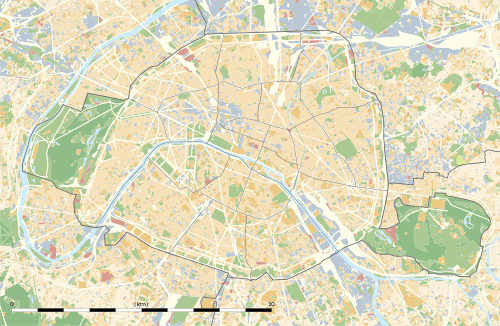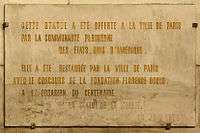Île aux Cygnes
|
Île aux Cygnes from the top of the Eiffel Tower. The Statue of Liberty replica is at the far end. | |
 Île aux Cygnes | |
| Geography | |
|---|---|
| Location | Paris, France |
| Coordinates | 48°51′10.03″N 2°17′00.95″E / 48.8527861°N 2.2835972°ECoordinates: 48°51′10.03″N 2°17′00.95″E / 48.8527861°N 2.2835972°E |
| Area | 0.013 km2 (0.0050 sq mi) |
| Administration | |
|
France | |
Île aux Cygnes (French pronunciation: [il o siɲ]; English: Isle of the Swans) is a small artificial island on the river Seine in Paris, France, in the 15th arrondissement. It was created in 1827 to protect the port of Grenelle. It should not be confused with an earlier Île des Cygnes that was attached to the Champ de Mars in the late 18th century.
The uninhabited island is 850 metres (2,789 ft) long and 11 metres (36 ft) at its widest point, making it the third-largest island in Paris.[1] A tree-lined walkway, named L'Allée des Cygnes (Path of Swans), runs the length of the island.[2] Since 2012, there has been a public workout space with bicycles and a climbing wall underneath the Pont de Grenelle, close to a Statue of Liberty replica.[1]
The island is crossed by three bridges: the Pont de Grenelle, the Pont Rouelle and the Pont de Bir-Hakeim. It is served by the Passy and Bir-Hakeim Métro stations.

Statue of Liberty replica
A notable feature is a quarter scale replica of Liberty Enlightening the World, commonly known as the Statue of Liberty, 22 metres tall and facing west in the direction of its larger sibling in New York City. Inaugurated by President Marie François Sadi Carnot on 4 July 1889,[3] nearly three years after its US counterpart, it was given to the city of Paris by the Parisian community in America to mark the centennial of the French Revolution.
The statue originally faced east, toward the Eiffel Tower, but it was turned west in 1937 for the world's fair hosted in Paris that year. At its base is a commemorative plaque, and the tablet in its left hand bears the inscription IV Juillet 1776 = XIV Juillet 1789, recognizing the American Independence Day and the French Bastille Day.
In 1998, on the occasion of the "Year of France in Japan", the 14-ton statue was transported to Japan and displayed on Odaiba, an artificial island in Tokyo Bay, before returning to Paris the following year.[4]
A smaller statue is located in the Musée d'Orsay and another can be seen at the Musée des Arts et Métiers.[5]
 The replica Statue of Liberty
The replica Statue of Liberty Plaque on statue
Plaque on statue
References
- 1 2 Frédéric Moussaïan (17 April 2014). "Île aux Cygnes". Michelin. Retrieved 21 November 2015.
- ↑ "L'Allée des Cygnes". Another Day in Paris. 27 March 2012. Retrieved 21 November 2015.
- ↑ "France's Liberty Statue". The New York Times. 5 July 1889. Retrieved 22 December 2009.
- ↑ "Statue illumination kicks off 'Year of France' event". The Japan Times. 28 April 1998. Retrieved 21 November 2015.
- ↑ Helmut Koenig (4 May 1986). "Tracing the roots of a grand lady". Chicago Tribune. Retrieved 21 November 2015.
External links
 Media related to Île aux Cygnes at Wikimedia Commons
Media related to Île aux Cygnes at Wikimedia Commons
